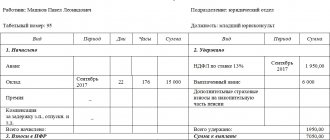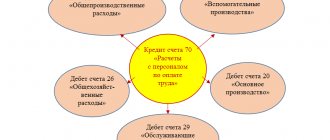Very often, individual entrepreneurs and LLCs with hired employees are interested in the question of how to withhold personal income tax from employees’ wages. In our material today we will look into this issue.
We will also look at how to return over-withheld personal income tax.
Types of deductions from wages (or from other income) can be divided into the following groups:
1. Mandatory, which are carried out on the basis of the norms of the current legislation of the Russian Federation. 2. Deductions at the initiative of the employer (in accordance with labor legislation). 3. Deductions at the initiative of the employee (based on a corresponding statement written by him).
Based on the legislation of the Russian Federation, all deductions that are made from an individual’s salary belong to the first group of deductions and are mandatory.
Features of personal income tax deduction from wages
Personal income tax withholding from wages in 2021 is carried out on the basis of the tax base, tax deductions and tax rates. It should be noted that they are used to calculate income tax only for residents of the Russian Federation. The tax rate, depending on individual income, can be:
- for residents of the Russian Federation - 9%, 13% and 35%;
- for non-residents of the Russian Federation - 30%.
In accordance with Article 217 of the Tax Code of the Russian Federation, some income is not taxed and is not taken into account when calculating personal income tax.
Tax deductions affect the calculation of personal income tax. Let's look at them in a little more detail. A tax deduction is the amount by which the tax base is reduced (before calculating the amount of tax payable).
The types of personal income tax deductions are as follows:
Standard deductions (provided to the following categories of citizens):
- parents who are dependent on a student (who is under 24 years of age);
- parents (adoptive parents, guardians) who have minor children.
The right to receive a deduction for children appears from the month of birth of the child, or from the period of his adoption, registration of documents for guardianship.
The standard tax deduction for children is: 1,400 rubles (1–2 children), 3,000 rubles (3 or more children).
Please note that from January 1, 2021, a bill approved by the Government of the Russian Federation came into force, according to which the threshold amount for receiving a deduction increases. Now it is not 280,000 rubles (per year), but 350,000. The calculation is carried out on an accrual basis from the beginning of the year. In 2021, this amount will not change and will remain at the 2021 level in the amount of 350,000 rubles.
Also, starting from 2021, the deduction for each disabled child to parents (adoptive parents) was increased from 3,000 to 12,000 rubles. For adoptive parents and guardians, the deduction will be increased - from 3,000 to 6,000 rubles.
In 2021, a deduction in the amount of 6,000 rubles is provided to guardians, adoptive parents, trustees for each child recognized as disabled before reaching 18 years of age. In 2018, the same amount is provided for a deduction for disabled children of groups 1 and 2, full-time students under the age of 24.
In 2021, a deduction in the amount of 12,000 rubles is provided for parents of disabled children up to the age of 18, or for a disabled person of groups 1 or 2 who is a full-time student up to 24 years of age.
When calculating wages, a deduction of 3,000 rubles in 2018 is provided to the following categories of employees:
- participants in the liquidation of consequences at the Chernobyl nuclear power plant and other objects exposed to radioactive contamination;
- citizens participating in nuclear weapons testing;
- disabled people of the Second World War;
- military personnel who became disabled while participating in hostilities.
When calculating wages, a deduction of 500 rubles in 2018 is provided to the following categories of employees:
- heroes of the USSR and the Russian Federation;
- participants in military operations to defend the country;
- concentration camp prisoners;
- citizens staying in Leningrad during the siege;
- disabled children, as well as groups 1 and 2;
- workers who have suffered radiation sickness, evacuated from radioactive zones, etc.
Social deductions (provided for the following purposes):
- for personal training or for teaching children;
- for treatment;
- for the purchase of medicines;
- for pension provision.
Property deductions (provided for the following purposes):
- car sales;
- purchase (sale) of real estate (apartment, house, land).
The property deduction can only be used once.
Property deductions are discussed in detail in Article 218 of the Tax Code of the Russian Federation.
Personal income tax rate
As a general amount, a deduction of 13% of the income that the payer received during one period (month) is applied. If, for example, an individual entrepreneur works on a patent, then he does not qualify for this rate, since he does not pay personal income tax at all on activities within the scope of the patent. Therefore, for the purpose of economical income taxation, the patent system is considered to be the most suitable.
As for dividends, they are also taxed at a general rate of 13%.
In addition to the main bet, there are deductions of other sizes, which depend on the situation. So, from any winnings and prizes at various advertising events, you will have to pay 35% of them to the budget. But only from an amount of 4,000 rubles per year.
A similarly increased rate applies to interest on deposits in domestic banks. Savings on interest that must be paid for the loan will also have to be paid 35%.
In some cases, 30% will have to be left in the treasury from income from securities of domestic companies (Article 214.6 of the Tax Code of the Russian Federation).
In general, the default rate of 30 percent applies to tax non-residents of the Russian Federation. True, there are exceptions. For example:
- dividends from Russian businesses are taxed at a rate of 15%;
- for income from employment, completely different prices are also established (Article 227.1 of the Tax Code of the Russian Federation);
- professionals with good qualifications pay, like all citizens of the Russian Federation, 13%;
- refugees or those who have received temporary asylum are also equated in this matter to residents of the Russian Federation.
Procedure for withholding personal income tax from the minimum wage
If a citizen receives a minimum income that is no more than the established subsistence level, this does not exempt him from paying personal income tax, which will be calculated according to general rules.
An employee is entitled to only one standard tax deduction. The only benefit that can be summed up is the deduction for each child.
That is, when calculating personal income tax on an employee’s minimum salary, the tax will be withheld at the established rate of 13% or 30% minus the amount of the benefit.
The employer can withhold additional payments to the FSSP or alimony only after the personal income tax has been calculated.
The procedure for withholding personal income tax for a separate division of the organization
In accordance with paragraph 7 of Article 226 of the Tax Code of the Russian Federation, an organization that has separate divisions pays income tax for individuals at the location of each of them. The amount of personal income tax payable is determined on the basis of the amount of income of taxpayers that was received under civil contracts and employment contracts. Income tax is paid at the location of the separate division of the organization.
One important point should be paid attention to. Let's assume that an employee worked in several separate divisions of an LLC for a month. In such a situation, the withholding of personal income tax and payment of tax on the income of a given individual is made to the budgets at the location of each of the separate divisions of the organization. The time actually worked in each of the separate divisions of the organization is also taken into account.
Income tax on salary
Income tax in Ukraine is one of the mandatory taxes that form the country’s budget. It is paid by all enterprises and individual entrepreneurs. To understand whether the employer has calculated income tax correctly, it is worth knowing how this happens.
What is income tax?
Recently, a single income tax of 18% has been established in Ukraine. It is paid by taxpayers in our country and abroad. Essentially, this is the difference between monthly income and expenses for the cost of goods, services and work, sales, etc.
Income tax in Ukraine is a direct tax paid by legal entities. As a rule, a hired worker working for the owner does not calculate the tax himself. This is what accounting does. However, any employee should know how much he pays to the budget in taxes every month.
To do this you need to have the following numbers.
What data you need to keep in mind:
There are several figures that are relevant in 2021 that help calculate the amount of income tax withholding from wages:
- minimum wage – 3723 hryvnia;
- cost of living – 1762 hryvnia (from January 1, 2021);
- tax social benefit – 881 hryvnia;
- The maximum salary at which a social tax benefit is accrued is 2470.
Using these figures, you can calculate how much tax will be withheld from wages.
How to calculate income tax on salary
Let's look at a simple example. An employee of an enterprise receives a minimum salary per month. That is 3723 hryvnia. Such an employee is not entitled to a social benefit, because his salary is greater than the maximum at which one can count on such a benefit. That is more than 2470 hryvnia. Next, let’s calculate the amount of income tax using the algorithm:
- Let's calculate the personal income tax: 3723 (minimum wage) x 18% (unified personal income tax) = 670.14 hryvnia.
- We calculate military duty: 3723 (minimum salary) x 1.5% (military duty rate) = 55.85 hryvnia.
- The tax will be: 670.14 + 55.85 = 725.99 hryvnia.
Thus, an employee receiving the official minimum wage will receive 2,997.01 hryvnia in hand. That is, 3723 hryvnia – 670.14 hryvnia.
Other, more complex cases are also possible. For example, when an employee is entitled to social benefits (for example, if the employee is a person who is supporting a child with a disability), when the employee does not work full time or wants to resign of his own free will in the month for which the salary will have to be calculated. Then the calculation algorithm will change slightly.
Readers are also interested in:
Source: https://www.dinero.ua/stranica/novosti/podohodnyj-nalog
What is not subject to personal income tax calculation?
We have already mentioned that among the income there are those that are not subject to income tax calculation, namely:
- social pensions;
- social benefits;
- maternity benefits;
- scholarships;
- alimony;
- unemployment benefits;
- compensation (daily expenses);
- lump sum maternity benefit;
- monthly allowance for child care up to 1.5 years;
- monthly compensation for child care up to 3 years old.
The full list is contained in Article 217 of the Tax Code of the Russian Federation.
Refund of over-withheld personal income tax in 2021
In order to make a personal income tax refund, an individual must write a statement, which can be written in any form. The document must include the taxpayer's bank account details. It is to him that the excess withheld personal income tax will be returned.
Today, there are two options for returning excessively withheld personal income tax.
Option 1
After the expiration of the tax period, that is, at the end of the reporting year, when settlements related to the employee have already been completed, the individual entrepreneur does not have the right to refund the excess withheld income tax. In this case, the taxpayer can independently contact the tax service to receive the funds due to him.
Tax officials themselves will recalculate personal income tax if the employee provides them with the following list of documents:
- statement;
- declaration;
- documents confirming the applicant's right to return.
The money will go to the bank account specified in the employee’s application.
Option 2
When personal income tax payments for an employee have not yet been completed, an individual entrepreneur can independently pay the individual. The procedure in this situation is as follows:
1. Check the employee’s statement. 2. Recalculate income tax. 3. Prepare an accounting statement. 4. Notify the employee about the overpayment of personal income tax. 5. At the request of the employee, return the funds to him. 6. Make changes to the tax card (it indicates accruals, transfers and withholdings of income tax).
The individual entrepreneur is obliged to notify the employee of the fact of excessive tax withholding and inform him of the amount within 10 days from the moment this fact is discovered.
Deadlines for returning excessively withheld personal income tax
An individual entrepreneur makes a refund of income tax from funds that must be transferred to the budget both for a specific taxpayer and from the income of his other employees.
Refunds of over-withheld personal income tax must be made within three months from the date of receipt of an application for a refund from an individual. If the individual entrepreneur does not pay the employee the amount on time, the entrepreneur is obliged to pay interest to the employee.
It may happen that an individual entrepreneur does not have the opportunity to refund income tax to an employee due to the fact that the individual entrepreneur’s accounts are frozen. In such a situation, the employee needs to contact the tax office, which will refund the personal income tax to the individual at its own expense.
Deductions
Understanding how income tax is calculated, it is worth saying that another important feature of the implementation of its social component is the provision of various types of deductions from the base for its calculation. Their action is based on the fact that the payer was exposed to certain, not small, expenses throughout the tax period. For example, purchased real estate, a car, or paid for education. For such persons, special articles of the Tax Code apply. They assume the presence of deductions: social, property and standard. Therefore, before calculating income tax on wages, the position of an individual is checked with the Tax Code. So, they are prescribed 3 types of standard deductions:
- 3000 rub. every month if the individual worked or served in critical conditions;
- 500 rub. reduce the base for payers associated with the factor of war or emergency;
- 1400 rub. concern a large audience of people with children. And when a third child appears in the family, the amount of the deduction increases: for two children its amount will be 2,800 rubles, and for three – already 5,800, not 4,200 rubles. This principle is relevant for each subsequent child.
The property deduction is the most tangible for the payer. It can only be obtained once. The amount is limited to 2 million rubles from the price of housing, etc. If we are talking about paying interest on a mortgage loan, then a limit of 3 million rubles has been introduced.
Before calculating income tax, you must submit the appropriate document to the employer or directly to the Federal Tax Service in order to obtain the right to a reduced tax taking into account the above amounts. The real economic effect can only be felt after tax reporting has been submitted and personal income tax has been paid.
There are also several cases where the payer has the right to tax breaks due to various social schemes. For example:
- when a person participates in charitable events at his own expense;
- if there are expenses for training in the tax period;
- in case of using medical services;
- when making contributions to your pension to private funds.
In total, the size of the entire set of social deductions should not exceed 120,000 rubles (excluding the first point). If this value is greater in the reporting, the column with personal income tax reductions must be adjusted to this limitation.







